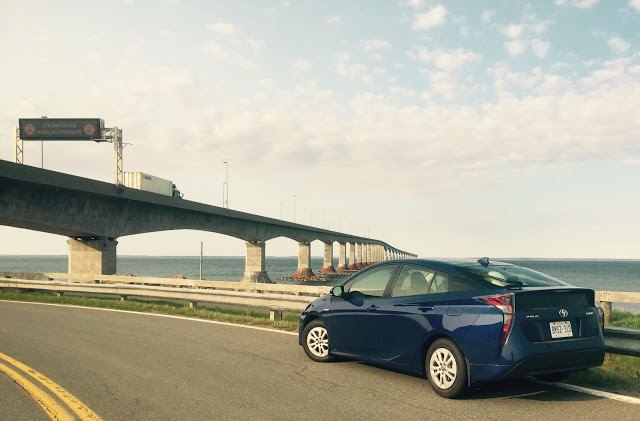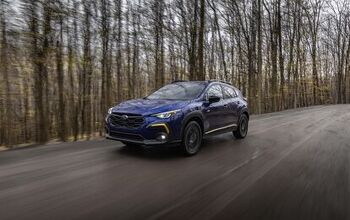Ford C-Max Vs. Toyota Prius: Ford Wins, But Nobody Heeds My C-Max Recommendation
The overwhelming majority of mileage I accumulated in manufacturer-supplied test cars in May was spent in direct hybrid rivals from Ford and Toyota.
The 2016 Ford C-Max SE, Ford’s base model, visited for one week. Then following a stretch in the 2016 Volkswagen Golf R, a base version of Toyota’s new, fourth-generation Prius was dropped off for an extended stretch.
I’ll take the C-Max, thanks.
Scratch that. I’ll take the Golf R.
But if left to choose between the dedicated hybrids from Ford and Toyota, the C-Max is the one I’d have. So why do car buyers plug their ears when they hear such a recommendation?
Before we deal with the reasons why not a single one of the personal connections to whom I made the suggestion ever purchased or leased a C-Max, or the fact that the American car buyers are presently five times more likely to acquire a Prius than the C-Max, consider a handful of reasons why the C-Max is such a great pick.
DRIVING
Nearly four years after its launch, the 2016 C-Max looks frumpier than ever. Besides which, it’s an economy-minded hybrid that loves to stay in EV mode. Yet the C-Max is a decidedly driver-friendly car, a car which may not beg to be thrown down a twisty road but nevertheless shines when you ask for swifter progress.
COMFORT
The latest Prius, admittedly with a roomier rear seat, has made great strides in refinement. But the C-Max was already there: quiet, vibration-free, and with a consistently smooth powertrain.
MONEY
The Prius’s base price is $25,095, and though there are low-interest finance rates available, the price gap is nothing to sneeze at.
Yet while the C-Max is an engaging on-road companion, is distinctly more comfortable than the Toyota, and is now spectacularly affordable, there are obvious issues with the Blue Oval Prius alternative.
TECH
The Prius interior is full of graphics and meters and minders and buzzers and beepers – many of which are admittedly beyond frustrating – that feel more 2020 than 2012.
SPACE
In practice, the shape is not remotely as conducive to swallowing strollers, suitcases, and assorted detritus as our Prius tester did for a 500-mile round trip to Prince Edward Island and back. It would have been possible in the C-Max, but it would have been a pain.
FUEL
The C-Max’s figures, originally maligned and changed, now rest at 40 mpg. We did 47 mpg in a C-Max in 2013; 47 mpg again last month. (We made no attempts to maximize fuel economy in either the C-Max or the Prius, but conditions which were neither hot nor cold and routes which clearly favored efficiency produced impressive results.)
Perhaps more importantly, the Prius is simply the obvious choice. It’s the Toyota Camry of dedicated hybrids; the Lexus RX of green family cars. It’s the obvious choice. The Prius was here first, it’s legendarily reliable, it was more efficient first, and it’s still more efficient in a game where fuel economy numbers are the game.
Meh, the $11 per 1,000 miles* Prius fuel savings aren’t enough to change my mind, not when the Toyota’s seats irritate my spine, not if the Prius continues to insist on detached and appliance-like transportation, not if the Prius costs substantially more money out the door.
So C-Max Hybrid it is. Or is the plug-in C-Max Energi, laden with nearly $10,000 in incentives, the proper choice?
* Based on our real-world week-long tests and $2.50/gallon for regular fuel.
[Image Source: © 2016 Timothy Cain/The Truth About Cars]
Timothy Cain is the founder of GoodCarBadCar.net, which obsesses over the free and frequent publication of U.S. and Canadian auto sales figures. Follow on Twitter @goodcarbadcar and on Facebook.
More by Timothy Cain
Latest Car Reviews
Read moreLatest Product Reviews
Read moreRecent Comments
- Sayahh I do not know how my car will respond to the trolley problem, but I will be held liable whatever it chooses to do or not do. When technology has reached Star Trek's Data's level of intelligence, I will trust it, so long as it has a moral/ethic/empathy chip/subroutine; I would not trust his brother Lore driving/controlling my car. Until then, I will drive it myself until I no longer can, at which time I will call a friend, a cab or a ride-share service.
- Daniel J Cx-5 lol. It's why we have one. I love hybrids but the engine in the RAV4 is just loud and obnoxious when it fires up.
- Oberkanone CX-5 diesel.
- Oberkanone Autonomous cars are afraid of us.
- Theflyersfan I always thought this gen XC90 could be compared to Mercedes' first-gen M-class. Everyone in every suburban family in every moderate-upper-class neighborhood got one and they were both a dumpster fire of quality. It's looking like Volvo finally worked out the quality issues, but that was a bad launch. And now I shall sound like every car site commenter over the last 25 years and say that Volvo all but killed their excellent line of wagons and replaced them with unreliable, overweight wagons on stilts just so some "I'll be famous on TikTok someday" mom won't be seen in a wagon or minivan dropping the rug rats off at school.



































Comments
Join the conversation
Eight days ago I purchased a C-Max SE. Like many here I have owned far too many new cars. I bailed on my 11th new Honda when I picked up my new 2013 Accord Sport. I had enough of the noise and QC issues. I read enough semi negative stuff on the C-max but the price was unreal with the rebates. I had a 2010 Honda Insight prior to the Accord. There is absolutely no advantage on the Insight- none. People must drive like maniacs because after just 200 miles of use I always arrive back home getting 48-50 mpg and that is solely rural driving. And I always drive from 5-7 mph over the posted speed. You really have to here with the long rolling hills. I never use the Eco button because I think it hurts your mpg like it did on the Insight because you need to get your foot in it more because it dogs the car out too much. I drive briskly off the line and get up to speed and I play no hyper miling or any of that nonsense and I use the AC like any other car. The car has plenty of zip and the 2L puts my Honda motors to shame. All of this on real 225/50/17 tires and rims. Why no back up camera? Too many buttons and I think all of the dash hybrid play screens distract driving and the car is super smooth but the interior noise level is nice but not Lexus-Buick nice. I'm actually thrilled with the car but I haven't been without a tach since 1978- nuff said. The car drives a bit like a Golf- very nice and the out the door pricing is unreal. I no longer get thrilled too much as I buy cars like I buy burgers. I think this is going to stay. I did test drive the Prius and Prius V and a Jetta hybrid prior to buying. After my brief ownership with a car not broken in yet I can't understand the old MPG issue. If you ever been near Fairhill-Elkton MD. near the Delaware line and see our wide open hilly roads you can tell this isn't hybrid country and I go up those hills at 60-65 mph and I get bang near 50 mpg. crazy. BTW- That's Route 273...
I am a C-Max owner now shopping for a 2017 Prius as a replacement. Although I purchased the C-Max for its better acceleration and wanted to buy American (this is not my only Ford), I've never had a car with such profound problems with reliability. The C-Max is now in the shop for a transmission replacement which will take many weeks because the Ford dealer where the car sits has limited throughput on major drivetrain repairs. Since the car was delivered to the shop on a flatbed truck it isn't moving elsewhere. I now see there have been a few TSBs issued by Ford regarding drivetrain failure, and a Google search of CVT/transmission/drivetrain failure shows a good representation of this problem. Due to unreliable engineering, this is an unfortunate misuse of tens of millions of dollars donated by the US Gov't to develop the HF35 transmission under the Recovery Act. https://obamawhitehouse.archives.gov/the-press-office/2016/02/25/fact-sheet-recovery-act-made-largest-single-investment-clean-energy This was the first car I've had break down in traffic in 3 decades. I dutifully made my NHTSB report on this unsafe vehicle, because of this experience I will never buy another Ford for personal or business use - and I have (soon to be had) been a supportive Ford shareholder for 25 years.